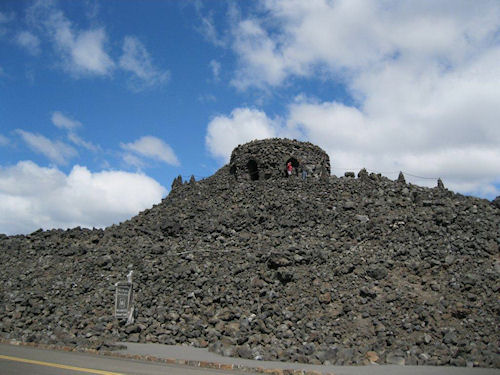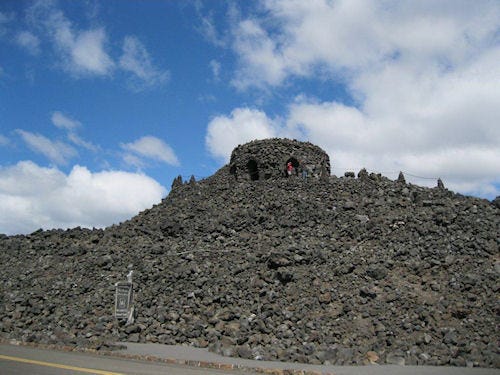
I warned readers when I got the new tent trailer rig last year I would have some travel experiences to share. Fortunately, you do not need to worry about a slide show.
Traveled to Central Oregon where the Three Sisters Mountains dominate the Cascades, but knew little about what else awaited me there. Well, it was very eye-opening.

Dee Wright Observatory
I had no idea that the lava fields near the mountains were so extensive as if they went on eternally. When we visited the lava house built on top of the craggy field -- built by the Civilian Conservation Corps in the '20s -- it was an experience in bizarre. The structure, built using the lava stones, almost hides blending into the dark rocks that surround it. Off in the distance were Mt. Washington and some other snowy peaks sawtoothing the horizon.
Looking one way at the pristine Three Sisters and then back at the lifeless lava, it was a contrast harsh enough to break the imagination.
Down from the mountains and into the woods, we found the Metolius River where fish are so hard to catch (flies only) that the state of Oregon offers a prize for anyone landing one on the lower river area. Seems (locals say) so many anglers using catch and release have let their fish go back to the river that the denizens of the deep are now more wary when it comes to taking the hook.
I saw veteran flyfishing guys who didn't look happy there.
There is also a little cabin on the river near a country store that looks like something Kinkade would paint. Salivated over wanting this river nook, but not to be.

Three Sisters and a World-Class Flyfishing River
On yet another outing, saw the Smith Rock. Now, that sounds everything but exciting, but it is actually breathtaking itself. The tall rimrocks are the remnants of a collapsed caldera out in the middle of nowhere in Oregon, breaking up the landscape with a "what the heck" neck-jerk.
Climbers were all over the walls of this oddity of Oregon nature, and we watched the people specks inch their way to the jagged peaks. More energy on a hot day that I would like to have expended.
So many wonders I did not know about right here in our back yard, so to speak, less than 200 miles from home.
We also were attacked by a gang of chipmunks determined to rob us of anything we may have had with us to eat. I usually don't feed the wild critters since that makes it hard for them to forage in winter, but it was delightful to watch the little kids offer them bits of corn. I guess Mother Nature includes children's play in her realm of sustainability.
What's nice about camping is that you can just laze around and nap and read and munch and nap some more.
It was daunting, however, to set up our little trailer home between behemoth RVs measuring more than 40 feet long, equipped with pneumatics that slide out new rooms, gourmet kitchens, lodge-like living rooms and bedrooms big enough for three Moose.
Nevertheless, I am happy with the little rig, enjoying the same scenery those in the eight-wheelers do.
And with fewer payments and lots of less gas.
About the Author(s)
You May Also Like




